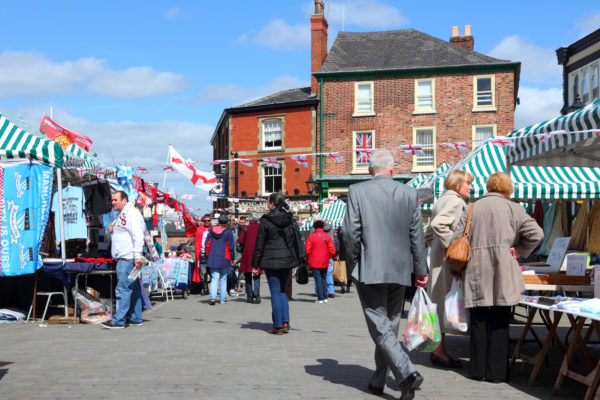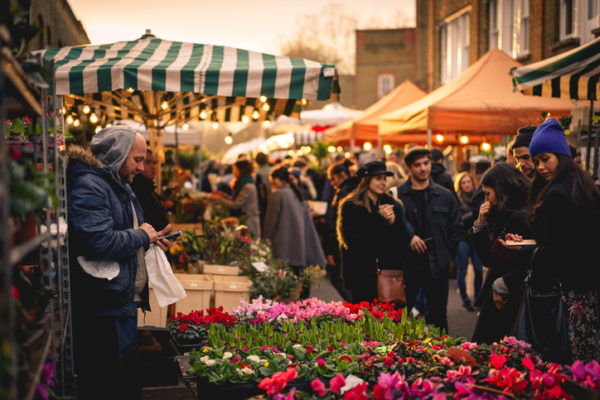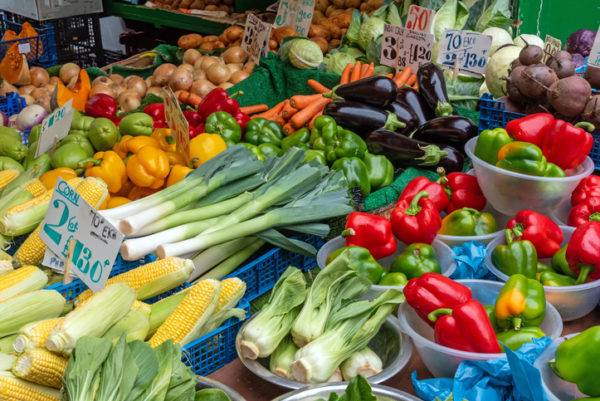Traders’ perspectives on the community value of markets
This article by Dr Myfanwy Taylor outlines some of the work of Understanding and Enhancing the Community Value of Traditional Retail Markets in UK Cities (Markets4People), an ESRC-funded project that explores the challenges facing retail markets in low-income areas and their wider importance not only to local economies, but also their immense social value to residents. This article has been reposted from the Markets4People website.

On 8th April 2019 we held three workshops with traders on the community value of markets at the NMTF Conference in Hull (click here to read the conference report in Market Times). Having heard from managers and campaigners in similar workshops last year, we were keen to hear from traders about their experience and perspective. We thank our Co-Investigators at the NMTF for making space in the packed conference programme for the discussions, including Chris Savage, Rachel Harban and Brendan Dyson who worked with the University of Leeds team to facilitate the three workshops. In total, more than 30 traders participated in the workshops, bringing their experiences from a wide range of fairs, indoor and outdoor markets, including Barnsley, Barrow-in-Furness, Beverley, Blyth, Cambridge, Canterbury, Derby, Doncaster, Great Yarmouth, Huddersfield, Keswick, Manchester, Newcastle Grainger, Norwich, Rotherham, Sheffield Moor, Stockport and Warrington. The majority of traders came from markets in the North East, North West and Yorkshire and the Humber, with a small number coming from markets in the East Midlands, East and South East of England, reflecting the wider make-up of the NMTF Conference. We hope to engage with traders from other parts of the UK throughout the remainder of the project.
As this blog post describes, the three workshops confirmed that markets are more than economic spaces for the traders who earn their livings there. The discussions powerfully communicated traders’ pride and passion for the quality, value and customer service they provide, and the contribution markets make to reducing loneliness, improving mental health and supporting vulnerable people. Many of the traders we heard from were concerned about the impact of new, upmarket food offerings on markets’ traditional roles and were determined that markets can and should remain spaces that are open to all. Traders also highlighted the threat of supermarkets and shopping centres, worsening public transport connections, market redevelopments, incompetent and disconnected councils, problems with the market environment and antisocial behaviour. The workshops also produced useful suggestions for how to enhance community value, in particular by improving transport connections and re-introducing housing to town centres; professional partnership working between operators and traders; improvements to the market environment, such as adding more benches and holding events to encourage social interaction; and, importantly, retaining connections between food and retail traders (in particular through redevelopment schemes) in order to ensure benefits continue to flow between the two.
The community value of markets
Markets’ contributions to social interaction and social inclusion came out strongly from the three workshops. Traders described markets as a social gathering, a social event, a day out, a meeting place and a space for hanging out and getting together. Traders played an important listening role for some customers, almost acting like social workers. These functions made a contribution to improving mental health and reducing loneliness, in particular amongst elderly people and in rural communities where people may have few other opportunities for social interaction. Several traders described how important markets were for lonely elderly people, some of whom visited the market each day at the same time, forming relationships with other customers and traders over time which provided something of a safety net. For example, customers and traders would notice if someone was missing and enquire after them.
Workshop participants also highlighted markets as inclusive spaces, open to all, from the top 5% to the bottom 5%, including people who spent time in the market because couldn’t afford to heat their own homes or who needed to buy small quantities until they were next paid for example, as well as people with mental health difficulties and homeless people. Markets provided an affordability which people couldn’t get elsewhere. Traders valued and were proud of markets’ open, inclusive and welcoming nature, which they felt distinguished them from supermarkets and shopping centres. At the same time, traders described how the presence of vulnerable people in the market sometimes caused problems such as fights or aggressive behaviour, which were off-putting for other customers and which they did not always feel well-equipped to deal with. Traders therefore both celebrated markets’ role in improving mental health, reducing loneliness and supporting vulnerable people, whilst also understanding this role in relation to a lack of more formal mental health provision and safeguarding for vulnerable people.
Traders also described markets as community hubs, community spaces and ‘people’s places’, as crucial parts of communities. Markets were compared to pubs (minus the alcohol), and associated with local and regional identities and feelings of belonging, respect and pride. One workshop participant suggested this meant people might have their own vision for their market, which might differ from that of the council or other operator. Markets’ associations with distinctive local and regional identities also meant they contributed to making a place attractive to tourists, naturally bringing a uniqueness which high street chains could not. These roles meant markets had the potential to bring local people and tourists together. Some workshop participants also described markets as providing a space for people from different cultures and ethnic groups to interact or even just be together in the same shopping space.
There was also some discussion in workshops about the benefits of markets in supporting trade and enterprise, although this was not as strong a theme as might have been anticipated. Participants who did speak about this theme emphasised the value of markets as spaces of small and independent business. One trader also highlighted the role of markets in providing access to local goods, connecting customers with local trades and farmers, reducing food miles and reducing excessive use of natural resources. The market environment also provided an additional benefit in the form of opportunities for small independent businesses to learn from one another.
The features of traditional retail markets
As the discussions shifted to traditional retail markets, traders in all three workshops highlighted value, quality and customer service as defining features. Traders explained that value and quality were particularly important in poor areas, where ‘every pound counts’. They also described a particular approach to customer service associated with traditional retail markets, involving taking the time to share their knowledge, expertise and passion for their products with customers through a friendly and patient approach. Workshop participants clearly distinguished traditional market traders’ customer service from that offered by supermarket workers. As a group of independent businesses operating within the same space, traders’ specific identity and approach produced a particular atmosphere and feel strongly associated with traditional retail markets.
The other major theme explored in this section of the discussions was whether traditional retail markets were associated with specific commodities. Several traders identified fruit and veg, meat, fish, seafood, cheese, bread, hardware, haberdashery, clothing and cafes as traditional commodity lines, providing a ‘one-stop shop for weekly necessity commodities’. As shopping and eating habits were changing, some participants felt there was a reduced need for traditional lines, identifying a new range of food businesses offering more expensive prepared food for a different clientele, who were prepared to pay a premium, e.g. a vegan stall or a lobster and champagne stall. Several workshop participants explained how these new food traders were lasting longer than expected, and that traditional traders (e.g. selling bacon rolls) were struggling. They suggested that new food traders were more likely to only open approximately 11am to 3pm to catch the lunchtime trade and often preferred to only operate on the weekends when higher income, professional customers were more likely to visit. They therefore felt that the new food traders had different interests to traditional traders, and were ‘killing the week market’.

Other participants challenged the separation between traditional and new traders, arguing that there was ‘no such thing’ as a traditional trader, that customers perceptions of what a traditional trader was would vary and that markets and traders always adapted to the needs of communities. Some markets served poor communities with good quality and value everyday basics (e.g. bin bags), others offered more expensive quality hats and scarfs for tourists, for example, and some were able to successfully serve multiple communities. Another participant highlighted that some customers bought some expensive goods and other cheaper goods, giving the example of Asian students in Sheffield who would spent a lot of money on fresh fish and very little money on household cleaning products and bin bags in the same market. In a similar way, another participant described how market traders were using Deliveroo and Just Eat to provide customers with the convenience many people now needed, lacking the time to shop and cook that they might have had in the past. These traders therefore stressed that traditional retail markets can and must welcome and adapt to new customers and their shopping habits.
Regardless of their view of whether new food traders were a threat to traditional market traders or not, participants strongly defended the continued relevance and value of traders providing value and quality commodities to low-income communities. Not everyone could afford artisan products, especially not everyday. One participant described ‘traditional’ lines such as haberdashery as a kind of ‘public utility’ which should remain available for all. There was a strong desire for markets to continue to provide good quality and value everyday necessities even as they changed and adapted, remaining a place for everyone to come together. While there was some interest in applying quotas or limits to new food offerings (as in the case of Norwich, we heard), traders also emphasised the need for councils and other operators to understand the value of both ‘traditional’ and ‘new’ traders and for ‘traditional’ and new ‘traders’ to learn how to work alongside one another.
Threats to the community value of markets
Traders identified a wide range of threats to the community value of markets, associated with trends and issues operating in different arenas and at different scales, from the individual trader to the retail sector as a whole. For many traders, supermarkets and out-of-town shopping centres (and the free parking they provide) remain the major threat for markets. Participants described the threat as including the number and variety of supermarkets located within a 15 minute walk of many traditional retail markets; their longer-opening hours; their convenience even for regular older elderly customers (who might come to the market for a cup of tea and then go on to a supermarket for their shopping); and local authorities’ reliance on parking charges, which drives customers to the free parking of the out-of-town shopping centres. Online shopping was mentioned by surprisingly few traders, given the dominance of this issue in wider debates within the UK markets sector. Several traders also mentioned the worsening accessibility of some markets such as Doncaster, which had been cut off from public transport connections through town centre redevelopments.
Redevelopment of markets was also identified as a threat, in part, because, as one participant noted, markets often occupied central and valuable locations which councils wanted to sell or redevelop. Traders operating from fairs also noted that new buildings were removing spaces that would previously have been used for fairs. Another trader argued that efforts to shift traditional retail markets towards events markets was pushing up running costs for operators as it took four people to put up a gazebo, we were told.
The ongoing case of the Barnsley Markets redevelopment was mentioned several times. Traders from Barnsley shared concerns that new restrictions on adapting or extending stalls and long leases would make it harder for them to adapt to changing customer needs. They also described the knock-on effect of traders leaving the market through the redevelopment process. For example, the loss of a trader selling tights meant that some women who had previously bought a lot of fruit and veg from other traders no longer visited. Traders were also unhappy about being asked to open on new days and to stay open longer, when their customer base had already left for the day to go home or to pick children up from school. The issue of opening hours was also discussed more broadly; traders recognised that markets needed to change from traditional 9am-to-5pm opening hours but felt traders couldn’t be expected to work 10am-to-10pm when many could not employ staff, especially in the current poor economic climate. They identified alternative options of introducing core opening hours (with flexibility around this), or shifting opening hours to later in the day.

Several traders were extremely critical of council operators, suggesting that officers were disconnected from the realities of customers’ everyday lives. Workshop participants explained that councils sometimes had visions of people coming out to eat at markets after they got home from work, which were not realistic for people on low-incomes. They identified a failure on the part of operators to understand both what it was like for customers to get by on little money, and the basics of profit and loss for traders. Incompetence, a failure to listen and a lack of joined-up thinking were also mentioned.
Another key threat identified by traders was problems with the market environment, including cleanliness, upkeep, a lack of ‘dwell space’ and anti-social behaviour. Anti-social behaviour was a particular concern of one of the three workshops, in which traders from Cambridge, Derby, Keswick, Norwich, Rotherham and Sheffield described the negative impact on customers of begging, gangs, drug taking, graffiti, illegal street trading (including of fake goods), and false fundraising not being addressed by the authorities. Rent levels, the limited younger customer base and the lack of understanding or evidence about what a traditional market is and what its value is were also identified as threats.
Enhancing community value
Traders’ suggestions for how to enhance the community value of markets mainly focused on actions which could be taken by operators and traders themselves. The dominance of supermarkets, lack of free parking and disconnection from public transport led some participants to propose ways in which it could be made easier for customers to access markets. Ideas included improving links with public transport, cheap bus links and free parking; introducing more residential property to town centres, including for students; and introducing more smaller markets throughout residential areas, so that people were less likely to shop at small supermarket outlets or to drive to larger ones. These discussions reflected the fact that many of the threats identified by traders were associated with wider trends or processes, therefore requiring action beyond markets themselves. In addition, workshop participants made several suggestions for improvements traders could make themselves, for example selling unique, artisan and personalised products; offering products which appealed to young people; getting together to offer packaged meal kits; using less plastic; using social media; providing excellent customer service; and continuing to adapt and evolve.
The main proposition put forward in the workshops for enhancing community value, however, was for improved professional partnership working between operators and traders (a small number of participants also added a third actor, communities). While a small number of participants identified specific roles for each party, most wanted to see more dialogue and meetings between operators and traders and other relevant actors (e.g. refuse collectors) to resolve issues and problems. Joint working on community and charity events was specifically identified as important.
Traders had a number of suggestions for improvements to the market environment itself, in particular benches, events and integrating food and retail. Beyond basic cleanliness, a decent shopping environment and toilet facilities, many traders wanted to see more benches introduced to encourage dwell time and social interaction. One trader described Huddersfield Market’s new bench as ‘amazing’, suggesting it had an enormous social value. Participants also mentioned other creative ideas to respond to and enhance markets’ social roles, including provision of a ping pong table, bowling lane, drop-in centres for the elderly, music events and charity events. A partnership with the University of Huddersfield to create an art exhibition space was mentioned as an example of how markets’ cultural roles could be enhanced, helping both the university and the market to connect with new audiences. Importantly, traders argued clearly that food and retail traders should remain connected with one another, so that ‘traditional’ traders can benefit from ‘new’ food traders. This proposition was contrasted with the Barnsley market redevelopment, where we were told it was possible to visit the new food court without encountering the general retail market at all.
Next steps
We will be analysing and exploring traders’ insights further over the next few months as we draw together our findings from the first phase of the project and move on to developing reports, tools and initiatives to assist traders, operators and communities in understanding and enhancing the community value of markets. We will also hold a second round of workshops with traders, operators and campaigners in the latter part of the project, where we will share our findings and other outputs. We will continue to work closely with project partners, steering group members and others in order to make the most of the opportunities offered by this collaborative, policy and action-oriented research project.